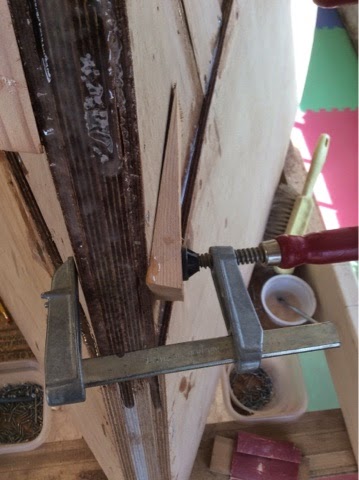I have a lot of pics describing things that have not made it into the blog. So this post will be a set of random shots and comments.
This pic shows the 6 mm outer layer before many sanding or shaping of any sort.
Here you can see how ragged the edges got where the 6 mm layers meet the hog. Perhaps I should have fitted better? I relied on the planar and sander to bring all into one plane along the top of the hog. Could have done this better. I put my time and energy and attention to the parallel edges of the pieces running from chine to hog. You can see where I way over sanded the very front of the hog. I later glued in a piece of fir (and then largely chipped it out when planing the leading edge of the inner hog).
Gluing the hog to the inner stem. Lots of challenging angles here.
I am not sure I mentioned that I ran out of 6 mm plywood before I finished the sheathing. Big problem at the time as the closest place to get marine plywood is an hour away and only open during work hours. I had one piece missing (see below) and another of equal size near at the stem. The picture below is of all the scraps. I was not at all wasteful in cutting the overlapping pieces. I was able to get another sheet but wished I had purchased an extra sheet from Doug. I could have pieced together some little pieces, but it seemed not a good idea.
The missing piece.
A pic of the transition before I fit the first layer.
More pics of the rough, dry fit.
































